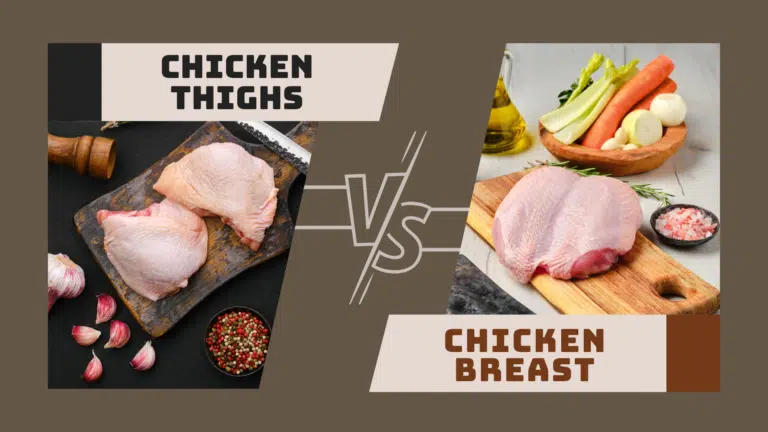A Price Revolution in the Poultry Aisle That’s Changing How We Cook
Gone are the days when chicken breasts ruled the roost! If you’ve wandered down the meat aisle recently, you might’ve done a double-take at the price tags That’s right – in many stores across America, chicken thighs are now more expensive than chicken breasts This flip-flop in pricing has shocked shoppers and upended decades of poultry economics. So what’s going on? Let’s dive into this meaty mystery!
The Traditional Chicken Hierarchy: A Brief History
For decades, chicken breasts were the undisputed champions of the chicken world. They commanded premium prices while thighs were relegated to the “budget bin” of poultry cuts.
As Sarah Zhang noted in her recent interview with NPR, “if you went back something like 10, 15 years ago, thighs cost almost half as much as a chicken breast” This price gap wasn’t random – it reflected America’s obsession with white meat that began around the 1980s
During this period:
- The first deboned chicken breast plants opened
- Health concerns about fat and cholesterol drove consumers toward leaner white meat
- Chicken producers made “their money on the front half of the chicken and losing money on the back half”
- Dark meat was largely exported to other countries where it was more appreciated
Why The Sudden Flip? The Thigh’s Rise to Fame
1. Flavor Revolution
Let’s be honest – chicken thighs just taste better! They’re:
- Juicier and more flavorful due to higher fat content
- More forgiving to cook (harder to dry out)
- Better for braising, grilling, and slow-cooking methods
As Red Table Meats points out, “Beyond flavor, thighs are praised for their forgiving nature when cooking. With more fat and connective tissue, they remain tender and moist even with extended braising, grilling, or roasting. Chicken breasts, in contrast, dry out easily if slightly overcooked.”
2. The Chef Effect
Professional chefs have long preferred thighs for their superior taste and texture. This preference has gradually trickled down to home cooks, especially as food media and cooking shows have highlighted dark meat’s virtues.
3. Changing Nutritional Attitudes
The low-fat craze of the ’90s has given way to a more balanced approach to nutrition. As Home Dining Kitchen explains, “perspectives on nutrition have evolved. The low-fat mania of the 90s has given way to a more balanced approach focused on high-quality fats and overall diet composition.”
4. The Technology Factor
Here’s something surprising I discovered – the rise of boneless, skinless chicken thighs is actually a tech story! According to Zhang, boneless skinless chicken thighs weren’t widely available until about 20 years ago.
“Machines are really, really good at” deboning thighs, she explains, because “there’s really only one bone in the thigh.” This technological advance made thighs more convenient and appealing to consumers who wanted the flavor without the hassle.
5. Social Media’s Impact
Food photography on platforms like Instagram has boosted thigh popularity. As Red Table Meats notes, “Pictures of delicious chicken thigh dishes get lots of likes and shares. Food photography has made chicken thighs a must-have for both home cooks and chefs.”
The Economics Behind the Price Change
The chicken pricing shift isn’t just about consumer preferences – it’s also basic economics:
Supply and Demand Basics
As demand for thighs has increased, so have prices. It’s econ 101! What’s interesting is that chicken producers can’t just make more thighs without also producing more breasts. A chicken only has two thighs and two breasts, so the whole supply chain gets affected.
As Red Table Meats explains: “When demand for thighs goes up, producers must find buyers for the accompanying breasts. This balance means pricing fluctuates for both cuts based on seasonal demand, global exports, and other factors.”
Regional Variations
Prices vary significantly by region. According to Home Dining Kitchen:
“In the southern United States, chicken thighs are often cheaper than in other parts of the country. This is because the south is home to many large chicken producers, which can keep prices low due to economies of scale. In contrast, in areas with limited chicken production, such as the northeast, chicken thighs may be more expensive due to higher transportation costs and lower supply.”
Price Comparison
Let’s look at the current price ranges for different chicken cuts according to Home Dining Kitchen:
| Cut | Price per pound |
|---|---|
| Boneless, skinless chicken breasts | $3.50 – $5.50 |
| Chicken thighs | $2.50 – $4.50 |
| Chicken wings | $2.00 – $4.00 |
| Chicken drumsticks | $1.50 – $3.50 |
While thighs aren’t always more expensive than breasts everywhere, the gap has dramatically narrowed. In many stores, especially those in urban areas or trendy neighborhoods, thighs now cost the same or more than breasts.
Factors That Affect Chicken Thigh Prices
Several factors influence how much you’ll pay for chicken thighs:
1. Processing Method
- Bone-in vs. boneless: Boneless thighs cost about $1-2 more per pound than bone-in
- Skin-on vs. skinless: Skinless options command a premium
2. Production Method
- Conventional: Typically the least expensive
- Free-range: Mid-tier pricing
- Organic: Most expensive, often $2-4 more per pound than conventional
3. Seasonal Factors
Prices tend to rise during grilling season and around holidays when demand spikes.
4. Store Type
Prices vary dramatically between:
- Discount stores
- Traditional supermarkets
- Specialty/organic markets
- Butcher shops
Smart Shopping Strategies for Chicken Lovers
If you’re feeling the pinch from rising thigh prices, try these money-saving tips:
1. Buy the Whole Bird
The most economical option is still buying the whole chicken. As Red Table Meats suggests, “Consider buying whole chickens and portioning them yourself to maximize savings.”
Learning basic butchering skills can save you tons of money over time. Plus, you’ll get bones for stock – bonus!
2. Look for Sales
Chicken goes on sale regularly. Stock up during promotions and freeze what you won’t use immediately.
3. Consider Bone-In Options
Bone-in thighs are significantly cheaper than boneless and often have more flavor. Yes, you’ll have to work around the bone, but the savings are worth it.
4. Buy in Bulk
Many stores offer “family packs” or bulk options at lower per-pound prices. Portion them out at home and freeze.
5. Compare Stores
Price differences between stores can be substantial. I found a $2 per pound difference between my local premium grocery store and the discount market just a mile away!
Is This Price Flip Permanent?
Will chicken thighs remain more expensive than breasts? It’s hard to predict, but industry trends suggest this might be our new normal.
As Red Table Meats concludes: “In the evolving poultry landscape, chicken thighs are holding their own against once-dominant breasts… The thigh is truly mightier than ever before.”
However, market forces could eventually balance things out. If thigh prices continue rising, some consumers will switch back to breasts, potentially stabilizing prices.
My Personal Take
I gotta say, as someone who cooks a lot, I’m not surprised by this price shift. Thighs are just better for most recipes! They’re practically impossible to mess up, whereas I’ve ruined plenty of expensive chicken breasts by overcooking them just slightly.
When I’m making curry, stir-fry, or anything braised, I always reach for thighs. The only time I still buy breasts is for chicken salad or when I need very even, clean pieces for a specific presentation.
If you’ve been loyal to breasts because you think they’re healthier, maybe it’s time to reconsider. The nutritional differences aren’t as significant as once thought, and the cooking benefits of thighs are enormous. Plus, with current pricing, you might actually save money making the switch to breasts!
The Bottom Line
So, are chicken thighs more expensive than breasts? The answer is: increasingly, yes – especially in urban areas and for higher-quality options. This represents a complete reversal from historical pricing patterns and reflects changing consumer preferences and culinary trends.
Whether you’re Team Thigh or Team Breast, one thing’s clear – understanding these market shifts can help you make smarter choices at the grocery store. And maybe, just maybe, if you’ve been ignoring one cut in favor of another, it might be time to diversify your chicken portfolio!
What’s your experience? Have you noticed thighs costing more than breasts at your local store? Drop a comment below – I’d love to hear your thoughts on this poultry pricing puzzle!

What to Serve with Chicken and Rice
Any of the below side dishes would taste great with this easy chicken and rice recipe. Make a complete meal with any of these sides. These are all great combinations!
- A crusty loaf of homemade French bread or garlic bread.
- A small chopped salad topped with a zesty vinaigrette.
- Make parmesan roasted broccoli in the oven while the rice and chicken cook on the stove.
- Whip up more steamed vegetables and either serve on the side or mixed into your meal.
Store leftovers in an airtight container for 3-4 days in the refrigerator. When ready to reheat, take out of storage and warm it up in the microwave or on the stovetop until it is warmed through.
Brown rice takes longer to cook than long-grain white rice and typically requires a bit more liquid. For best results, I don’t recommend using brown rice in this recipe as it might not cook as well. If you’d like to give it a shot, try using 1 cup brown rice instead of 1.5 cups and let it cook for an additional 10 minutes or so to get tender.
Sure! Omit the meat and use vegetable broth in place of chicken broth when cooking the rice. You could always add in extra veggies to bulk it up more or serve it with cooked tofu for protein.
Instead of cooking on the stovetop, you can achieve the same delicious flavors by making this easy Instant Pot chicken and rice. Learning how to use the Instant Pot to make all your favorite recipes is a huge game changer in the kitchen!
Yes, you can freeze the leftovers although the texture in cooked rice-based dishes does tend to get mushy upon thawing.

How to Make Chicken and Rice
Making this easy chicken and rice dinner is quick and easy. This is going to be your go-to dinner each week, it is that delicious!

- Sauté the meat. Heat oil in a large pot over medium-high heat. Place chicken thigh pieces into heated oil and season with salt and pepper. Sauté for 5-7 minutes, until cooked through.
- Add in garlic and veggies. Add the diced onion and garlic to the skillet with the chicken and sauté for another 3 minutes. Next, add the carrots and celery.
- Cook rice. Increase heat to high and add broth, then stir in the rinsed rice. Bring to a boil, then reduce heat to low. Stir again and then cover and let simmer for 15 to 20 minutes, or until the rice is cooked (stirring occasionally).
- Add cheese and parsley. Stir in Parmesan cheese and fresh parsley. Add more salt, pepper, or seasonings if desired.
- Chicken. Use chicken breasts instead of thighs for a leaner alternative (thighs will result in more flavor).
- Pre-cooked chicken. You may also use cooked chicken in this recipe (such as rotisserie). Simply mix in the cooked meat after the vegetables have been sautéed.
- Garlic. If you are a garlic lover, add a few additional garlic cloves to the broth to help infuse more garlic flavor or garlic powder. Then remove the cloves before serving.
- Vegetables. Feel free to include extra vegetables like bell peppers, peas, or mushrooms. Simply add them in when sautéing the onions, carrots, and celery.
- Stock. Rather than using chicken broth, you can use vegetable stock instead.
- Herbs. You may substitute fresh parsley, thyme with basil or oregano if preferred.

3 Reasons to use chicken thighs vs. breasts
FAQ
Which part of chicken is most expensive?
Why use chicken thighs instead of breasts?
Chicken thighs are often preferred over breasts because they are more flavorful and tender due to higher fat content, more forgiving during cooking and less prone to drying out, generally less expensive, and easier to cook, especially for dishes requiring longer cooking times like braising or roasting. While breasts are leaner and better for dishes requiring a milder flavor or thinner cuts, thighs offer a richer taste, a more succulent texture, and are more forgiving for novice cooks.
Why are chicken thighs expensive now?
Chicken thighs are expensive due to the combination of increased demand, driven by their superior flavor and culinary versatility, and supply chain challenges like rising feed and labor costs, which have made them more popular and valuable. As chicken breasts become less dominant, thighs have replaced them as the “hot” cut in many markets, creating a new premium for this formerly cheaper alternative.
Should I buy chicken breast or thighs?
Both chicken breasts and chicken thighs are good sources of micronutrients including vitamin B12, iron, zinc, potassium, and phosphorus, however, the …Feb 20, 2024
